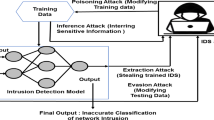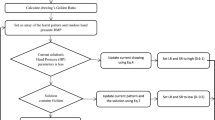Abstract
Artificial bee colony (ABC) is a recently introduced swarm intelligence algorithm (SIA). Initially only unconstrained problems were handled by ABC, which was later modified by embedding one more parameter called modified rate to handle constrained problems. Since then, ABC and its variants have shown a remarkable success in the domain of swarm intelligence optimization algorithms. The exploration capability of ABC is comparatively better than exploitation which sometimes limits the convergence rate of ABC while handling multimodal optimization problems. In this study the foraging process of two phases has been enhanced by embedding opposition based learning concept. This modification is introduced to enhance the acceleration and exploitation capability of ABC. The variant is named as O-ABC (Opposition based ABC). The efficiency of O-ABC is initially evaluated on 12 benchmark functions consulted from literature. Later O-ABC is applied for intrusion detection. The simulated comparative results have shown the competitiveness of the proposal.









Similar content being viewed by others
References
Al-Salamah M (2015) Constrained binary artificial bee colony to minimize the makespan for single machine batch processing with non-identical job sizes. Appl Soft Comput 29:379–385
Anand K, Ganapathy S, Kulothungan K, Yogesh P, Kannan A (2012) A rule based approach for attribute selection and intrusion detection in wireless sensor networks. Procedia Eng 38:1658–1664
Bolaji A, Khader A, Al-Betar M, Awadallah M (2013) Artificial Bee Colony Algorithm, its variants and applications: a survey. J Theor Appl Inf Technol 47(2):434–459
Dunn OJ (1961) Multiple comparisons among means. J Am Stat Assoc 56(293):52–64
Eesa AS, Orman Z, Brifcani AMA (2015) A novel feature-selection approach based on the cuttlefish optimization algorithm for intrusion detection systems. Expert Syst Appl 42(5):2670–2679
Elsayed S, Sarker R, Slay J (2015) Evaluating the performance of a differential evolution algorithm in anomaly detection. In: Proceedings of the IEEE Congress on Evolutionary Computation. Sendai, Japan, 25–28 May 2015, pp. 2490–2497
Franco E De, Hoz La, Garcia AO, Lopera JO, Correa E De, Hoz La, Palechor FM (2015) Implementation of an intrusion detection system based on self organizing map. J Theor Appl Inf Technol 71(3):324–334
Ganapathy S, Kulothungan K, Muthurajkumar S, Vijayalakshmi M, Yogesh L, Kannan A (2013) Intelligent feature selection and classification techniques for intrusion detection in networks: a survey. EURASIP J Wirel Commun Netw 2013:271. doi:10.1186/1687-1499-2013-271
Gao WF, Liu SY (2012) A modified artificial bee colony algorithm. Comput Oper Res 39(3):687–697
Hassanzadeh A, Altaweel A, Stoleru R (2014) Traffic-and resource-aware intrusion detection in wireless mesh networks. Ad Hoc Netw 21:18–41
Iftikhar A (2015) Feature selection using particle swarm optimization in intrusion detection. Int J Distrib Sens Netw. 11(10):806954. doi:10.1155/2015/806954
Ivona B (2015) Crossover-based artificial bee colony algorithm for constrained optimization problems. Neural Comput Appl 26:1587–1601
Kang F, Li J (2015) Artificial bee colony algorithm optimized support vector regression for system reliability analysis of slopes. J Comput Civ Eng. doi:10.1061/(ASCE)CP.1943-5487.0000514,04015040
Karaboga D (2005) An idea based on bee swarm for numerical optimization, technical report, TR-06. Erciyes University Engineering Faculty, Computer Engineering Department, Kayseri
Karaboga D, Basturk B (2007a) A powerful and efficient algorithm for numerical function optimization: artificial bee colony (ABC) algorithm. J Glob Optim 39:459–471
Karaboga D, Basturk B (2007b) Artificial bee colony optimization (abc) algorithm for solving constrained optimization problems. In: Proceedings of IFSA 2007, LNAI 4529, Springer-Verlag, Berlin, Heidelberg, pp. 789–798
Karaboga D, Gorkemli B, Ozturk C, Karaboga N (2014) A comprehensive survey: artificial bee colony (ABC) algorithm and applications. Artif Intell Rev 42(1):21–57
KDD Cup 99 Data, Information and computer science, University of California, Irvine. http://kdd.ics.uci.edu/databases/kddcup99/kddcup99.html. October 2007
Kıran MS, Fındık O (2015) A directed artificial bee colony algorithm. Appl Soft Comput 26:454–462
Kolias C, Kambourakis G, Maragoudakis M (2011a) Swarm intelligence in intrusion detection: a survey. Comput Sec 30(8):625–642
Kolias C, Kambourakis G, Maragoudakis M (2011b) Swarm intelligence in intrusion detection: a survey. Comput Sec 30(8):625–642
Li G, Niu P, Xiao X (2012) Development and investigation of efficient artificial bee colony algorithm for numerical function optimization. Appl Soft Comput 12:320–332
Livani MA, Abadi M (2011) A PCA-based distributed approach for intrusion detection in wireless sensor networks. In: Proceedings of Symposium on Computer Networks and Distributed Systems (CNDS) 2011. Tehran, Iran, 23–24 February 2011, pp. 55–60
Rahnamayan S, Tizhoosh HR, Salama MMA (2008) Opposition-based differential evolution. IEEE Trans Evol Comput 12(1):64–79
Sharma TK, Pant M (2011) Enhancing the food locations in an artificial bee colony algorithm. In: Proceedings of 2011 IEEE Symposium on Swarm Intelligence (SIS), 1–5, Paris, France
Sharma TK, Pant M (2013) Enhancing the food locations in an artificial bee colony algorithm. Soft Comput 17(10):1939–1965
Sharma TK, Pant M (2014) Redundancy level optimization in modular software system models using ABC. Int J Intell Syst Appl (IJISA) 6(4):40–48
Sharma TK, Pant M (2015) Improved search mechanism in abc and its application in engineering. J Eng Sci Technol (JESTEC) 10(1):111–133
Sharma TK, Pant M (2016a) Shuffled artificial bee colony algorithm. Soft Comput. doi:10.1007/s00500-016-2166-2
Sharma TK, Pant M (2016b) Distribution in the placement of food in artificial bee colony based on changing factor. Int J Syst Assur Eng Manag. doi:10.1007/s13198-016-0495-2
Sharma TK, Pant M, Ferrante Neri (2014a) Changing factor based food sources in artificial bee colony. In: Proceedings of IEEE Symposium on Swarm Intelligence (SIS), Orlando, Florida, USA, pp. 1–7
Tizhoosh HR (2005) Opposition-based learning: a new scheme for machine intelligence, In: Proceedings of International Conference on Computing Intelligent Modeling Control and Autom. Vienna, Austria, 2005, vol. I, pp. 695–701
Wang Y, Fu W, Agrawal DP (2013) Gaussian versus uniform distribution for intrusion detection in wireless sensor networks. IEEE Trans Parallel Distrib Syst 24(2):342–355
Xue B, Zhang M, Browne WN (2013) Particle swarm optimization for feature selection in classification: a multi-objective approach. IEEE Trans Cybern 43(6):1656–1671
Xue B, Zhang M, Browne WN (2014) Particle swarm optimization for feature selection in classification: novel initialization and updating mechanisms. Appl Soft Comput J 18:261–276
Zar JH (1999) Biostatistical analysis. Prentice-Hall, Englewood Cliffs
Zhu G, Kwong S (2010) Gbest-guided artificial bee colony algorithm for numerical function optimization. Appl Math Comput 217:3166–3173
Author information
Authors and Affiliations
Corresponding author
Ethics declarations
Conflict of interest
It is declared that there is no conflict of interest.
Rights and permissions
About this article
Cite this article
Sharma, T.K., Gupta, P. Opposition learning based phases in artificial bee colony. Int J Syst Assur Eng Manag 9, 262–273 (2018). https://doi.org/10.1007/s13198-016-0545-9
Received:
Revised:
Published:
Issue Date:
DOI: https://doi.org/10.1007/s13198-016-0545-9




